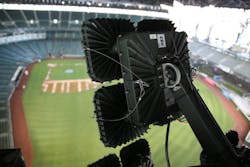Seattle Mariners retrofit ballpark with LED lighting for the playing surface (UPDATED)
KMW of Korea supplied Giga Tera LED fixtures to light the Major League Baseball venue and the team and league expect better visibility for players and fans.
The Seattle Mariners Major League Baseball (MLB) team has announced that its Safeco Field home ballpark is now lit with LEDs, making it the first MLB facility to light the playing field with solid-state lighting (SSL). KMW Inc of Korea, with US offices in Fullerton, CA, supplied its Giga Tera LED luminaire for the project. Planled consulted on the project that promises to deliver more uniform illumination on the field for players, and a better viewing experience for fans watching games from the stands or on HDTV screens at home.
LED lighting is increasingly penetrating the major sports domains, and this week the world sports spotlight will focus on the US National Football League (NFL) Super Bowl game to be played in Phoenix, AZ. Just back in September 2014 we covered the conversion of lighting in the NFL venue by Ephesus Lighting. Now a baseball stadium has adopted LED sports lighting technology with energy efficiency and low maintenance as compelling drivers for the project, but with optimum light quality a mandate.
"Thus far, our experience has indicated that the Mariners’ new LED technology at Safeco Field will be better for our players, fans in the ballpark, and viewers watching at home," said Joe Garagiola, Jr, senior vice president of standards and on-field operations for MLB. "We applaud the Mariners for an innovative step that promises to improve efficiency and the fan experience in numerous ways, all while serving as a welcome addition to our overall greening efforts."
Still, the energy- and maintenance-saving aspects of the LED sports lighting project are undeniably attractive. The team expects a 60–70% reduction in energy usage for the lighting. And the luminaires are rated for 100,000 hours of life, whereas the prior metal halide (MH) lighting required lamps to be changed every 3000 hours. The LED products also eliminate the 20-minute warm-up period associated with MH lighting. The LED sports lighting can be turned on or off or dimmed instantly.
"The benefits of converting to LED lighting are across the board from the play on the field to supporting the Mariners’ long-established sustainability goals," said Joe Myhra, Seattle Mariners vice president of ballpark operations. "The GigaTera fixtures represent the latest in LED technology. This project was the result of the work of many partners, including Planled and KMW, working together on this new approach to sports lighting."
The field lighting retrofit follows a pioneering human-centric lighting (HCL) LED-based project installed in the Mariners’ clubhouse for the players. Planled CEO John Hwang, Lighting Wizards principal Stan Walerczyk, and Harvard professor Dr. Steven Lockley worked on the project intended to help the baseball players prepare for a game and relax afterwards.
The tunable lighting allows the team to increase energy at the blue end of the visual spectrum prior to games to increase player alertness. After a game the team sets the lighting to a warm CCT to help the players transition to a rest cycle and help the players endure the long 162-game season with games contested 6–7 days per week.
To learn more about HCL and the potential benefits of blue-rich light, see our recent webcast on the topic.
We've also covered several other LED sports lighting projects in the past year. For example, the Stamford Bridge stadium, home of the Chelsea Football Club in England, was converted to SSL. And the English Premier League in which Chelsea plays soccer had a quality lighting mandate much like the US pro sports leagues.

Maury Wright | Editor in Chief
Maury Wright is an electronics engineer turned technology journalist, who has focused specifically on the LED & Lighting industry for the past decade. Wright first wrote for LEDs Magazine as a contractor in 2010, and took over as Editor-in-Chief in 2012. He has broad experience in technology areas ranging from microprocessors to digital media to wireless networks that he gained over 30 years in the trade press. Wright has experience running global editorial operations, such as during his tenure as worldwide editorial director of EDN Magazine, and has been instrumental in launching publication websites going back to the earliest days of the Internet. Wright has won numerous industry awards, including multiple ASBPE national awards for B2B journalism excellence, and has received finalist recognition for LEDs Magazine in the FOLIO Eddie Awards. He received a BS in electrical engineering from Auburn University.






